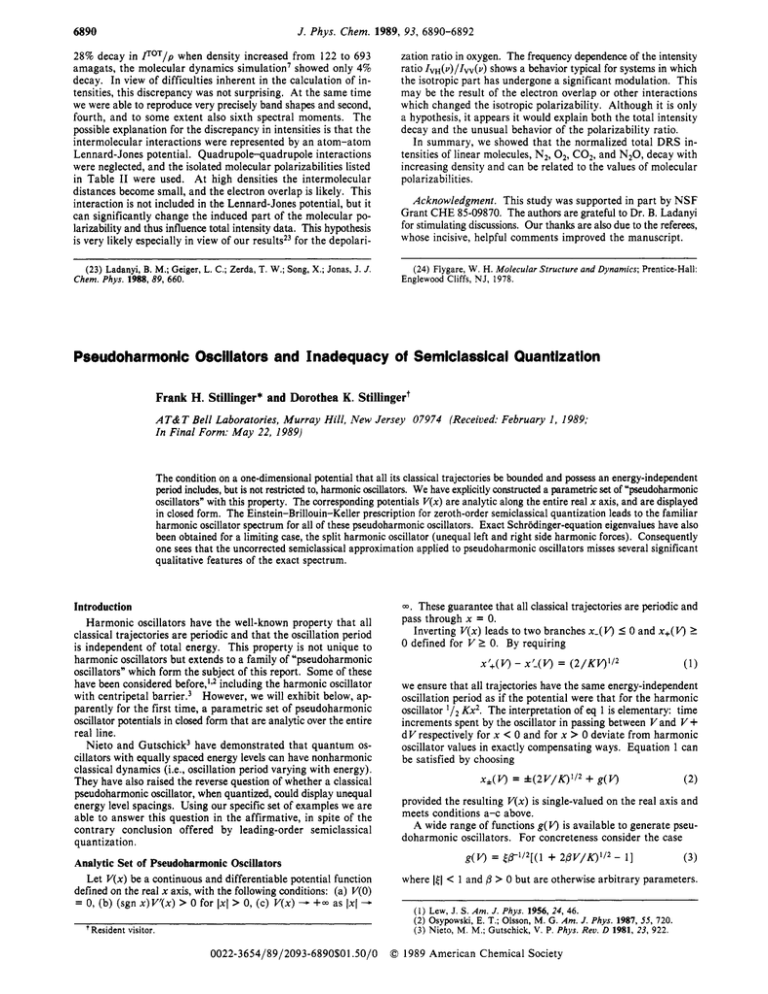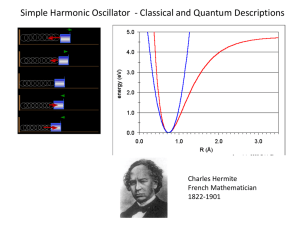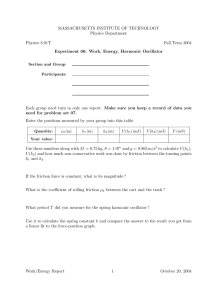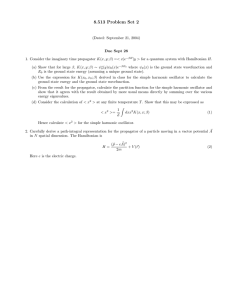Pseudoharmonic Oscillators and Inadequacy
advertisement

J. Phys. Chem. 1989, 93, 6890-6892
6890
28% decay in p o T / p when density increased from 122 to 693
amagats, the molecular dynamics simulation' showed only 4%
decay. In view of difficulties inherent in the calculation of intensities, this discrepancy was not surprising. At the same time
we were able to reproduce very precisely band shapes and second,
fourth, and to some extent also sixth spectral moments. The
possible explanation for the discrepancy in intensities is that the
intermolecular interactions were represented by an atom-atom
Lennard-Jones potential. Quadrupole-quadrupole interactions
were neglected, and the isolated molecular polarizabilities listed
in Table I1 were used. At high densities the intermolecular
distances become small, and the electron overlap is likely. This
interaction is not included in the Lennard-Jones potential, but it
can significantly change the induced part of the molecular polarizability and thus influence total intensity data. This hypothesis
is very likely especially in view of our results23 for the depolari-
zation ratio in oxygen. The frequency dependence of the intensity
ratio ZVH(v)/ZW(v)shows a behavior typical for systems in which
the isotropic part has undergone a significant modulation. This
may be the result of the electron overlap or other interactions
which changed the isotropic polarizability. Although it is only
a hypothesis, it appears it would explain both the total intensity
decay and the unusual behavior of the polarizability ratio.
In summary, we showed that the normalized total DRS intensities of linear molecules, N2, 02,CO,, and N 2 0 , decay with
increasing density and can be related to the values of molecular
polarizabilities.
(23) Ladanyi, B. M.; Geiger, L. C.; Zerda, T. W.; Song, X.;Jonas, J. J .
Chem. Phys. 1988,89, 660.
(24) Flygare, W. H. Molecular Structure and Dynamics; Prentice-Hall:
Englewood Cliffs, NJ, 1978.
Acknowledgment. This study was supported in part by N S F
Grant CHE 85-09870. The authors are grateful to Dr. B. Ladanyi
for stimulating discussions. Our thanks are also due to the referees,
whose incisive, helpful comments improved the manuscript.
Pseudoharmonic Oscillators and Inadequacy of Semiciasslcai Quantization
Frank H. Stillinger* and Dorothea K. Stillingert
A T& T Bell Laboratories, Murray Hill, New Jersey 07974 (Received: February 1 , 1989;
I n Final Form: May 22, 1989)
The condition on a one-dimensional potential that all its classical trajectories be bounded and possess an energy-independent
period includes, but is not restricted to, harmonic oscillators. We have explicitly constructed a parametric set of "pseudoharmonic
oscillators" with this property. The corresponding potentials V ( x )are analytic along the entire real x axis, and are displayed
in closed form. The Einstein-Brillouin-Keller prescription for zeroth-order semiclassical quantization leads to the familiar
harmonic oscillator spectrum for all of these pseudoharmonic oscillators. Exact SchrSdinger-equation eigenvalues have also
been obtained for a limiting case, the split harmonic oscillator (unequal left and right side harmonic forces). Consequently
one sees that the uncorrected semiclassical approximation applied to pseudoharmonic oscillators misses several significant
qualitative features of the exact spectrum.
Introduction
Harmonic oscillators have the well-known property that all
classical trajectories are periodic and that the oscillation period
is independent of total energy. This property is not unique to
harmonic oscillators but extends to a family of "pseudoharmonic
oscillators" which form the subject of this report. Some of these
have been considered before,'q2 including the harmonic oscillator
with centripetal barriere3 However, we will exhibit below, apparently for the first time, a parametric set of pseudoharmonic
oscillator potentials in closed form that are analytic over the entire
real line.
Nieto and Gutschick3 have demonstrated that quantum oscillators with equally spaced energy levels can have nonharmonic
classical dynamics (Le., oscillation period varying with energy).
They have also raised the reverse question of whether a classical
pseudoharmonic oscillator, when quantized, could display unequal
energy level spacings. Using our specific set of examples we are
able to answer this question in the affirmative, in spite of the
contrary conclusion offered by leading-order semiclassical
quantization.
Analytic Set of Pseudoharmonic Oscillators
Let V ( x )be a continuous and differentiable potential function
defined on the real x axis, with the following conditions: (a) V(0)
= 0, (b) (sgn x)V'(x) > 0 for 1x1 > 0, (c) V ( x ) +m as 1x1
-
-
'Resident visitor.
0022-3654/89/2093-6890$01.50/0
I
,
m. These guarantee that all classical trajectories are periodic and
pass through x = 0.
Inverting V ( x ) leads to two branches x-( V) I0 and x+( V) 1
0 defined for V 2 0. By requiring
x'+(V) - x'_(V) = (2/Kv)'/2
we ensure that all trajectories have the same energy-independent
oscillation period as if the potential were that for the harmonic
oscillator
Kx2. The interpretation of eq 1 is elementary: time
increments spent by the oscillator in passing between Vand V +
dvrespectively for x < 0 and for x > 0 deviate from harmonic
oscillator values in exactly compensating ways. Equation 1 can
be satisfied by choosing
x*(V) = *(2V/K)'/2
+ g(V)
(2)
provided the resulting V ( x ) is single-valued on the real axis and
meets conditions a-c above.
A wide range of functions g( V) is available to generate pseudoharmonic oscillators. For concreteness consider the case
+
g( V) = &w[(
1 2pv/K)1/2 - 11
(3)
where 151 < 1 and p > 0 but are otherwise arbitrary parameters.
(1) Lew, J. S. Am. J . Phys. 1956, 24, 46.
(2) Osypowski, E. T.; Olsson, M. G. Am. J . Phys. 1987, 55, 720.
(3) Nieto, M. M.; Gutschick, V. P. Phys. Rev. D 1981, 23, 922.
0 1989 American Chemical Society
The Journal of Physical Chemistry, Vol. 93, No. 19, 1989 6891
Pseudoharmonic Oscillators
With this choice eq 2 can be explicitly inverted to give a pseudoharmonic oscillator potential that is free of singularities along
the entire x axis:
+
TABLE I: Coefficients for Second-Order Dependence of Split
Harmonic-Oscillator Eigenvalues on the Anharmonicity Parameter 4
mi11
+ 2 t P 1 / 2+~P x ~ ) ' / ~ ] ] ~
V ( X )= '/zK(1 - t 2 ) - 2 { ~
lp"/2[1 - ( 1
n
0
1
2
3
4
5
(4)
= '/ZK[x2- t/3'/*x3
+ 0(x4)]
In the limit that p becomes infinite this reduces to a "split harmonic oscillator" potential:
lim V ( x ) = '/ZK(l - t)-2x2
8--
= '/ZK(l
+ t)-2x2
(x
I
$ p dq = ( n + y2)h
I
> 0)
(n = 0, 1 , 2, ...)
I
1
91
(5)
0
J ( E ) = 2?rE/w
c
71
6
E
w
(6)
where p and q are conjugate momentum and coordinate variables,
h is Planck's constant, and the action integral spans one period
of motion. As is well-known, this rule reproduces the exact energy
eigenvalues for the harmonic oscillator.
In the case of our pseudoharmonic oscillator set eq 4,the action
integral in eq 6 can be transformed into a sum of integrals over
potential Vbetween limits 0 and E, the total energy. Subsequent
appeal to eq 1 then easily leads to the result
5
c
c
4
3
(7)
0
0.2
0.6
0.4
4.0
0.0
E
where w is the energy-independent angular frequency
w = (K/m)Il2
1
I
( x C 0)
Conventional harmonic oscillator behavior is recovered as P approaches 0 for any t .
Semiclassical quantization has been a popular approach to
explaining spectra of simple dynamical systems for which action-angle variables can be defined.4 Extensions have also been
suggested to cover cases with coupled degrees of freedom for which
sufficiently regular classical trajectories e x i ~ t e d . ~ These
,~
extensions have had numerous useful applications to problems in
chemical
The Einstein-Brillouin-Keller semiclassical quantization rule
for a one-dimensional oscillator is"'
J =
C"
(1/4)(1
. , . . -In 2) = +0.0767132...
(3/4)(2 - 3 111.2) = -0.0595811...
(5/8)(7 - 10 In 2) = +0.0428301...
(7/24)(29 - 42 In 2) = -0.0327196...
(9/16)(25 - 36 In 2) = +0.0262695...
(11/240)(457 - 660 In 2) = -0.0218688...
(8)
Figure 1. Dependence of split harmonic oscillator eigenvalues on the
anharmonicity parameter t. Each e,, is an even function of E.
and m is the oscillator mass. Expression 7 is identical in form
with that for harmonic oscillators. Consequently the EinsteinBrillouin-Keller rule leads to an eigenvalue spectrum for pseudoharmonic oscillators
E,, = (n
+ l/,)fiw
(9)
which is identical with the harmonic counterpart. Note that
nonuniqueness of V(x)given semiclassical E;s is well-known from
one-dimensional RKR inversion.*
Energy Eigenvalues
Energy eigenvalues obtained from the full quantum mechanical
treatment of the pseudoharmonic set (4) are expected to be
continuous functions of the anharmonicity parameters E and P.
Therefore any discrepancy between such a treatment and the
semiclassical prediction (9) that appears in, say, the split harmonic
(4) Goldstein, H. Classical Mechanics; Addison-Wesley: New York, 1953;
p 306.
( 5 ) Eastes, W.; Marcus, R. A. J . Chem. Phys. 1974,61, 4301.
(6) Sorbie, K. S.; Handy, N. C. Mol. Phys. 1976,32, 1327.
(7) Noid, D. W.; Koszykowski, M. L.; Marcus, R. A. Annu. Reu. Phys.
Chem. 1981,32, 267.
(8) Miller, W. H. Science 1986,233, 171.
(9) Einstein, A. Verh. Dtsch. Phys. Ges. 1917,19, 82.
(10) Brillouin, M. L. J . Phys. (Paris) 1926, 7, 353.
(11) Keller, J. B. Ann. Phys. (New York) 1958,4, 180.
I
0
0.1
1
1
1
1
I
1
0.2 0.3 0.4 0.5 0.6 0.7 0.0 0.9 1.0
E
Figure 2. Difference between the two lowest eigenvalues as a function
of the anharmonicity parameter 5. The semiclassical approximation
predicts that this difference is identically 1.
oscillator limit /3
P.
-
would also obtain for some range of finite
The exact eigenfunctions for the split harmonic oscillator defined
in eq 5 above consist of parabolic cylinder functionsI2with separate
(12) Handbook of Mathematical Functions; Abramowitz, M., Stegun, I.
A., Eds.; U.S.Government Printing Office: Washington, DC, 1964; Chapter
19.
6892 The Journal of Physical Chemistry, Vol. 93, No. 19, 1989
Stillinger and Stillinger
variables for positive and for negative x . By imposing continuity
on eigenfunctions and their first derivatives at x = 0 one derives
the following transcendental equation for determination of the
en 5 E n / h w :
It is clear that the e, must be even functions of [; changing the
sign of ,$ is equivalent to switching sides of the split harmonic
oscillator, and it merely interchanges numerators and denominators
in eq 10.
By using standard properties of the r functionL3it is possible
to extract the small-[ behavior of the e;
I
0
1
0.1
I
I
0.2 0.3
I
0.4
1
I
I
I
0.5 0.6 0.7 0.0
E
Explicit values for the first few coefficients c, are displayed in
Table I. The striking feature of these results is that they alternate
in sign, revealing an initial tendency as [ moves from zero for
neighboring eigenvalues to pair (though this effect appears to
diminish with increasing quantum number n). This indicates a
deviation from the semiclassical prediction.
We have also carried out a numerical analysis of eq 10 to trace
out the full [ dependence of the en. Figures 1 and 2 exhibit some
results. The unequal level spacings initially detected by eq 11
persist until 161 reaches +1, a t which point the eigenvalues are
In this limit one half of the split harmonic oscillator has become
an impenetrable wall, and the eigenstates confined to the other
half correspond to the odd subset for the [ = 0 harmonic oscillator,
suitably rescaled.
The e,([) curves in Figure 1 have several notable features. Most
obvious is the infinite slope that develops as [ 1. From eq 10
it is possible to show that a square-root singularity is involved:
-
e,([)
=n
+ Y4 - d,(l
- ,$)l/z + 0 ( 1 - [)
Notice that the strength of this singularity increases logarithmically
with n.
With the exception of the ground state, none of the e,,([) curves
is monotonic over 0 I [ I1. Instead an oscillatory behavior
develops with increasing n, the amplitude of which is largest near
[ = 1. This characteristic is illustrated by Figure 3. Our nu(13) Reference 12, Chapter 6.
Figure 3. Vertically expanded view of a portion of the e&) curve,
illustrating the damped oscillatory behavior occurring for the larger
quantum numbers.
merical results suggest that en([) possesses n relative maxima and
minima in 0 < [ < 1.
The flattening that develops with increasing n in the e,,([) curves
for most of the f range confirms the belief that the semiclassical
quantization method should become more nearly exact the higher
the energy. However, the behavior is obviously nonuniform in
[, with the steep-walled limits 141 = 1 continuing to resist the
uncorrected semiclassical description, eq 9.
We note in passing that the classical partition functions
(canonical or microcanonical) for pseudoharmonic oscillators are
identical with those for the corresponding harmonic oscillator^.'^
Conclusion
Our results for pseudoharmonic oscillators stress the need for
caution in applying semiclassical quantization to problems of
physical interest. Subtle features of the eigenvalue spectrum are
missed by the semiclassical approach for the example investigated
here, and there is the possibility of analogous imprecision in more
complicated cases. Some engaging questions also arise from the
present work about coherent states for pseudoharmonic oscillators
that would be defined by the Nieto and Simmons a p p r o a ~ h , ' ~
which generalizes the well-known formalism for harmonic oscillator coherent states.I6 Finally, we have the open question
whether in any nontrivial sense pseudoharmonic potentials can
exist in two or more dimensions, and if they do, whether their
quantum dynamics can be chaotic."
(14) Hill, T. L. Srarisrical Mechanics; McGraw-Hill: New York, 1956;
Chapter 3.
(15) Nieto, M. M.; Simmons, Jr., L. M. Phys. Rev. Leu. 1978,41, 207.
(16) Howard, S.;Roy, S. K.Am. J . Phys. 1%7,55, 1109.
(17) Pechuhs, P. Phys. Rev. Lerr. 1983, 51, 943.





